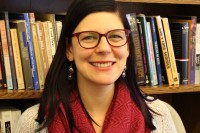Children’s books for tough conversations

We asked writers to tell us about a book for young children that provides the occasion for its readers—adults and children—to talk about large or difficult issues.
Natalie Carnes: Most books I read with my children end happily. Happy endings are important. They assure children that the world is a safe place to experiment and fail, to stretch themselves, and to become the person they are meant to be. But part of what I love about Jacqueline Woodson’s Each Kindness (illustrated by E. B. Lewis) is that it does not end happily. Sometimes unhappy endings are important too.
Each Kindness opens in winter. Snow is falling. A new girl, Maya, arrives at school in clothes and shoes the children have learned to regard as lower class. Throughout the book, Chloe, the child narrating the story, reveals the indifference and cruelty she and others show toward Maya.
Chloe repents after several months, but it’s too late. Maya has moved away. Illustrating the damage of clannishness and class prejudice, the book ends in a meditative mood as Chloe ponders the lost possibility of showing kindness to Maya. No adult voice breaks in to moralize the moment or wrap it into a neat lesson. It ends with Chloe in somber deliberation.
By resisting the temptation to turn to an adult voice for moral authority or to give Chloe one more chance for a happy ending with Maya, Each Kindness takes children seriously as moral actors. It shows them that their actions have real consequences in the world. It trusts them to reflect on the life they want to live, the risks of kindness, and the regrets that come when they refuse those risks. The book helps the child develop convictions that do not simply reflect the principles an adult articulates but that express a vision of self and world the child has learned to desire.
—Natalie Carnes, author of Motherhood: A Confession, forthcoming from Stanford University Press
Terrell Carter: Exodus recounts how the Israelites, after being freed by God’s hand from Egyptian rule, began a dramatic journey to a promised land they believed would have abundant resources and opportunities. Similarly, Follow Me Down to Nicodemus Town, written by Alexandria LaFaye and illustrated by Nicole Tadgell, tells the story of a family of African Americans that leaves the hardships of 19th-century Jim Crow Tennessee and migrates to rural Kansas. The book is based on an actual journey that a group—called Exodusters—made in the late 1870s.
In the story, a young girl named Dede and her hardworking family seek to take advantage of the Homestead Act of 1862, which offered people moving west 160 acres of farmland to work and call their own. Through a combination of determination and kindness from an unexpected source, Dede and her family make it to Kansas. But life isn’t perfect for them after they settle in on the rolling plains. To survive in this new land, they must depend on their faith in each other, lean into hard work, and welcome gracious acts performed by people who have an even more personal stake in the protection and development of the land.
Upon first reading the book, I was reminded of similar stories my grandfather told me about traveling from the Missouri Bootheel to St. Louis in search of work that would allow him to provide for my grandmother, my father, and his two younger siblings. Like the Exodusters, my relatives found that life didn’t always turn out as they’d hoped. But the more they depended on their faith, family, and community, the more manageable the journey became.
LaFaye’s story is simultaneously American and biblical. It’s the story of one family’s hope and belief in personal and communal perseverance, even when the outcome of the journey isn’t clear. Dede reminds us that having family to share in the story makes the journey toward the promised land even sweeter.
—Terrell Carter, pastor of Webster Groves Baptist Church and vice president and chief diversity officer for Greenville University
Sophfronia Scott: In the month before my son Tain’s seventh birthday, his best friend’s father, a man very close to him, died suddenly. It was Tain’s first direct experience with death. As the grief weighed heavily upon our family, I managed to have one single clear thought: Tain should talk to our rector, Pastor Kathie. I didn’t know what she would tell him, but I sensed this was the right thing to do in this vitally important moment. In her office she read and discussed with him Warren Hanson’s The Next Place.
The book captures the essence of the soul and imagines how this special part of us will live on after we die. The colorful images depicting sun, moon, stars, and rainbows are not childish. They express how we are all connected to an undying cosmos. The book’s message is freeing and hopeful.
As we left Pastor Kathie’s office, Tain said to me in the parking lot, “You’re right, Mama, I did need to talk to Pastor Kathie. It helped.” He said he now knew what to tell his friend about her father.
“What will you tell her?”
“I can tell her that he is going to be all right.”
“Yes,” I replied. “Yes.”
The following year, multiple copies of The Next Place were sent to our community after the mass shooting at my son’s school, Sandy Hook Elementary. I have my own copy now and have read it many times since. Each time I read it, I remain grateful for the comfort it gave Tain that night.
—Sophfronia Scott, novelist and coauthor, with her son, Tain Gregory, of This Child of Faith: Raising a Spiritual Child in a Secular World
Celeste Kennel-Shank: Kevin Henkes has a gift for writing and illustrating children’s stories that address ethical issues without being didactic. While many of his characters are animals, his stories realistically depict interpersonal conflicts. Lilly’s Purple Plastic Purse is a perfect example: a compelling story about asking for and receiving forgiveness.
From the opening pages, words and pictures complement each other to introduce us to Lilly and show her admiration for her teacher, Mr. Slinger, and his wonderful classroom. But even in a delightful setting, we all mess up and hurt each other. And it’s often not for the worst reasons. When Lilly ignores Mr. Slinger’s directions and disrupts the class repeatedly, it’s not out of malice or meanness but out of excitement: she wants to show off her new purse and sunglasses.
Lilly’s stomach lurches when she sees Mr. Slinger put the purse and glasses in his desk. Instead of immediately realizing her mistake, she gets angry and lashes out at him. When he responds with kindness, her stomach lurches again. This time, she recognizes it as a sign that she has hurt others by placing her desires above the good of all.
Readers of every age will benefit from the reminder that the best apologies are the simplest. Saying “I’m sorry” without excuses is enough (whether or not we add “really” 18 times, as Lilly does). Imagine how different the world would be if we all learned early in life to admit when we’re wrong and then seek to set things right.
—Celeste Kennel-Shank, Century contributing editor
Asa Lee: At the end of a visit to the Equal Justice Initiative, I stumbled into the gift shop, my mind still wrestling with stories of racism and inequality, and I found a children’s book that covers one of the darkest chapters in the modern civil rights movement and provides a way to talk about it.
The primary author of The Worst First Day: Bullied While Desegregating Central High is Elizabeth Eckford, one of the Little Rock Nine who integrated Central High School in Little Rock, Arkansas, in 1957. Eckford’s image made national news as she walked to school in front of the jeering and hate-filled crowd. Together with coauthors Grace and Eurydice Stanley, Eckford tells the truth about a horrible first day of school.
In age-appropriate but honest language, Eckford offers parents an opportunity to talk with children about the reality of racial segregation using a familiar concept: bullying. After reading this book with my own children, I’ve found that our conversations about race, bullying, and unfair treatment have become deeper and more authentic.
With the breakdown of civil discourse and the reemergence of demons from the past, Eckford offers a point of entry for conversations on the relevance of history, the meaning of race in America, and the legacy of the fight for civil rights. For families struggling to know how to talk about Charlottesville, the Charleston Nine, or instances of police brutality, The Worst First Day provides a way forward.
—Asa Lee, associate dean for campus life and director of African American church studies at Wesley Theological Seminary in Washington, D.C.
Eva Suarez: It’s never too early for parents to talk with children about the beauty of difference and what it means to live in a community where everyone is welcome. I have warm childhood memories of Daniel Pinkwater’s The Big Orange Splot—and it turns out my parents fondly remember reading it to me too.
Mr. Plumbean lives on what he and his neighbors are proud to call a “neat street,” where every house is exactly alike. After an unexpected paint accident, however, Mr. Plumbean’s house turns wildly bright and tropical—to his unexpected delight and his neighbors’ chagrin. As the neighbors take turns trying to change Mr. Plumbean’s mind, more and more of them find themselves converted to his new way of thinking. The way they live could be a reflection of who they are, and their differences could even be what brings them real joy.
By the end of the story, the street is no longer neat. It’s a collection of exciting, cheerful, and very different homes. The neighbors proudly say together, “Our street is us and we are it. Our street is where we like to be, and it looks like all our dreams.”
With its straightforward language and pleasantly simple illustrations, the book leaves room for parents and children to have conversations about what they observe, both about Mr. Plumbean’s neighbors and about their own. How do we feel when we see people who differ from us in how they dress, how they eat, how they speak, or how they live? Is it OK to ask questions about the differences we see? What’s the difference between questions rooted in curiosity and those based on fear or hostility?
The Big Orange Splot gives parents an opportunity to emphasize a basic Christian truth: every person, no matter how they look or live, is a child of God, and all of God’s children deserve the chance to live happily and comfortably together.
—Eva Suarez, associate rector at St. James’ Church in New York City
Isaac S. Villegas: For the past year and a half, Rosa del Carmen has lived on the property our church rents as part of our efforts to protect her from ICE agents who have threatened to deport her to Honduras, the country she fled with her child 15 years ago. When church kids ask about Rosa’s situation—why she sleeps in the church office, why she can’t drive back home to Greensboro to spend time with her children, who only visit on the weekends—I turn to La frontera: El viaje con papá—My Journey with Papa.
The book recounts Alfredo Alva’s immigration story from the 1980s, when he and his father left La Ceja, Mexico, to make a new life in Kerrville, Texas—a home where the rest of their family would join them a few years later. Each page shows another scene along the way, from crossing the fury of the Rio Grande to hiding near an abandoned factory for a few weeks. The book is bilingual: “Saltamos muchas valles. Yo iba en silencio.” “We climbed many fences. I did not talk much—it took too much energy.”
Alva’s story—written with his neighbor Deborah Mills and illustrated by Claudia Navarro—walks readers through the fear a child experiences on el camino, the courage of migrants, and the joy of reunion. In sharing his experience, Alva invites us to consider the lives of our neighbors, those members of our communities who have endured such danger to rebuild for themselves a life in this country.
—Isaac S. Villegas, pastor of Chapel Hill Mennonite Fellowship in Chapel Hill, North Carolina
Elizabeth Palmer: What happened to Humpty Dumpty after all the king’s horses and all the king’s men couldn’t put him back together again? Author and Caldecott-winning illustrator Dan Santat imagines the next chapter of the anthropomorphic egg’s story in After the Fall: How Humpty Dumpty Got Back Up Again.
Santat’s tale begins on an optimistic note. Humpty recovers from his fall and walks out of the hospital. Soon after he arrives home, though, he realizes that “there were some parts that couldn’t be healed with bandages and glue.” He has trouble sleeping. He notices that he’s terrified of falling. His fear keeps him from doing the things he most enjoys in life, like sitting up on a wall to be close to the birds. Santat doesn’t use psychological terminology, but adult readers will realize that Humpty is struggling with post-traumatic stress disorder.
The book chronicles Humpty’s brave efforts to find enjoyment in life again after his experience of trauma. He has a good idea and implements it with some success. But he also experiences a big setback, confirming his intuition that “accidents happen. They always do.”
The message for children is clear: some things that happen in life are going to hurt you, and it will take some work to move past them. Even for privileged children like mine, whose biggest trauma most days is that a parent cuts their toast the wrong way, this message will resonate with what they’ve already intuited about life.
The way Humpty gets back up in the end is as grace-filled as it is simple. The final picture in the book says more than any of Santat’s words. To my Christian eyes, it looks a lot like resurrection.
—Elizabeth Palmer, Century books editor
Josina Guess: Patricia Polacco’s books are timeless resources of beauty and wisdom that I return to with ongoing appreciation. My favorite is Chicken Sunday. Her adept storytelling and beautiful illustrations weave together an inspiring tale that touches on themes of interracial and interfaith friendship, bullying, anti-Semitism, grief, racial profiling, handcrafting, generosity, and redemption.
Young Patricia and her neighbors Stewart and Winston—who became her brothers through a “solemn ceremony”—come up with a plan to get a church hat for their Gramma Eula Mae, who sings with “a voice like slow thunder and sweet rain.” But they must first regain the trust of the grumpy shopkeeper, Mr. Kandinsky, who has falsely accused them of egging his store. Art becomes the bridge, as the children make delicate pysanky, decorated eggs which remind him of his homeland, Russia, before World War II. As he smiles and pours the children a cup of tea, the tattoo of concentration camp numbers on his arms reveals the depth of his pain and leads to a redemptive moment of healing grace between neighbors.
When I read Chicken Sunday aloud to my young children I do not say “here is a narrative that deconstructs hierarchies of oppression” or “this is a story that honors the creativity and spiritual imagination of children.” But they notice, as I get choked up, barely whispering the words, that this story, like Gramma Eula’s laughter, speaks volumes from a “deep holy place inside.”
—Josina Guess, a writer who lives with her husband and their four children in rural Georgia
Kaitlin Curtice: The Boy with Big, Big Feelings, written by Britney Winn Lee and illustrated by Jacob Souva, is a wonderful resource for combating toxic masculinity. The author recently sent me the book, and as I sat down to read it to my children, I was in tears by the second page. I have seen in my children, who are only six and eight years old, how hard it is to manage feelings and to understand what it might mean to be feminine or masculine in this world. I remember the same overwhelming feeling when I was young.
Whether overtly or covertly, the American way of raising boys has been to teach them to be tough, to like sports and superheroes, to wear blue and green and whatever other “boy colors” are appropriate, and, over time, to embody the idea that they can take whatever they want without asking. It is the curse of domination and misogyny, something we’ve been passing to young men since the foundation of this country.
Having sensitive boys and listening to their feelings and concerns is a priority I’ve long shared with my partner. After I first read through Lee’s book with my children, I asked them what their feelings are like and if they ever feel overwhelmed. They effortlessly began to share their inner world with me.
This book is an invitation to a conversation we all need to be having, not just with our sons but with our all of our children. Feelings are universal. Safe spaces for children to share how they’re doing as they negotiate the big world they hold inside themselves should be universal too.
—Kaitlin Curtice, author of Glory Happening: Finding the Divine in Everyday Places
Ali Lufkin: In the small mining town of Leadville, Colorado, Saint George Episcopal Church serves a community meal five days a week. We break bread in the form of a hot gourmet lunch with our most vulnerable neighbors.
One year the local Head Start administrator asked if we would offer a story hour for their preschoolers during Thanksgiving week. The theme would be sharing. They would ask the parents to send canned goods to school that day, to be donated to the community meals.
Knowing that many of the preschoolers are from families who have eaten at the meals, I thought the idea of sharing with “the poor” would be confusing at best. I decided that we’d make soup together, inspired both by Marcia Brown’s classic tale Stone Soup and Jon J. Muth’s lovely retelling of it. Instead of canned goods, I suggested that each child be invited to bring something simple and fresh like a potato, raw carrots, or garlic.
“We’re going to make Stone Soup today!” I announced as the children arrived, shedding coats and mittens in the entryway. “It’s almost lunchtime, but we have run out of food, which is very, very sad. Would you help us?”
The children sat in a circle in the sanctuary, pews pushed to the side, a large pot in the center. I asked tiny Yesenia to add three stones (sterilized ahead of time) and Michael helped me pour a bit of fresh water over the top.
“Would someone help me stir the soup?” Yesenia began, followed by Michael, then Jose. “Do you think this looks good to eat?” Giggles circled the room.
We acted out the story together, loudly. I invited each child to add their item and stir the pot a bit, because “stones could use a little garlic and salt.” In turn, each child added something; celery, onions, potatoes, masa flour, cinnamon sticks, and even Yesenia’s grandmother’s cocoa powder. This would be the best soup ever, we agreed.
As the children filed out of the sanctuary, we passed the kitchen and handed the large pot to Perla, the meal coordinator for the day. As I waved good-bye, I heard Jose tell the teacher proudly, “My mom will like that chocolate soup today!”
—Ali Lufkin, priest at Saint George Episcopal Church in Leadville, Colorado
A version of this article appears in the print edition under the title “Growing up with books.”







